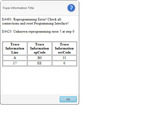Bought a used car (2018 Buick Regal TourX), have a J2534 capable programmer that can update GM calibrations. Paid $45 for the SDS VIN subscription and looked for updates to the various modules on this car.
Most modules were already at newest calibration, but there were a few that had updated ones available. Adaptive safety blah blah had some "performance updates", these installed no problem. ECU had a couple updates pertaining to diagnostic codes, installed no problem. I went through 3 or 4 of these until I got to "front drivers memory seat module."
This module came up as "unrecognized calibration." That's odd, all the other modules would tell me what calibration they were at and I could view calibration history (and the text that tells you what changed) to decide whether I wanted to update it or not. I said what the hell, lets update it. It went through 3 retries, and gave me the error code I have pictured. I tried replace&reprogram, reprogram several times, this module just won't take it and gives the error code every time. After the programming attempt, now the driver's side seat and all side mirror controls no longer work. Good thing I had it in a comfortable driving position!
With all that said, I feel the memory seat has never worked properly to begin with. The options in the on-screen comfort & convenience menu pertaining to "easy exit seat", "auto down mirror" and others related to this module would always disappear and reappear in the menu at random intervals. And it would never get my stored seat / mirror positions right. I'm going to assume this is a bad module that needs replaced.
In an effort to troubleshoot this, I updated all other calibrations (some I was staying away from because they didn't mention performance improvements) thinking they all need to be at current version. Now I'm getting a U026A DTC that won't clear-- this is a "lost communication to frontview camera module" code, which has disabled my lane keeping assist. I'm a bit stumped on this. My scan tool pulls up the module and lets me do a calibration, which involves driving around in daylight conditions (haven't done this yet), but I'm not sure a calibration will solve a communication DTC. SPS reports the module just fine and that it is at the latest calibration.
Any thoughts other than "if it ain't broke don't fix it?" Learned my lesson, but now that it's broke I need to fix it, any help / info would be appreciated! Again, the photo is of the error I received when I attempt to program the drivers side memory seat module. (passenger side has no such module). FWIW I verified all RPO options on the door label, so I'm 100% certain I answered all the questions in SPS correctly.
Most modules were already at newest calibration, but there were a few that had updated ones available. Adaptive safety blah blah had some "performance updates", these installed no problem. ECU had a couple updates pertaining to diagnostic codes, installed no problem. I went through 3 or 4 of these until I got to "front drivers memory seat module."
This module came up as "unrecognized calibration." That's odd, all the other modules would tell me what calibration they were at and I could view calibration history (and the text that tells you what changed) to decide whether I wanted to update it or not. I said what the hell, lets update it. It went through 3 retries, and gave me the error code I have pictured. I tried replace&reprogram, reprogram several times, this module just won't take it and gives the error code every time. After the programming attempt, now the driver's side seat and all side mirror controls no longer work. Good thing I had it in a comfortable driving position!
With all that said, I feel the memory seat has never worked properly to begin with. The options in the on-screen comfort & convenience menu pertaining to "easy exit seat", "auto down mirror" and others related to this module would always disappear and reappear in the menu at random intervals. And it would never get my stored seat / mirror positions right. I'm going to assume this is a bad module that needs replaced.
In an effort to troubleshoot this, I updated all other calibrations (some I was staying away from because they didn't mention performance improvements) thinking they all need to be at current version. Now I'm getting a U026A DTC that won't clear-- this is a "lost communication to frontview camera module" code, which has disabled my lane keeping assist. I'm a bit stumped on this. My scan tool pulls up the module and lets me do a calibration, which involves driving around in daylight conditions (haven't done this yet), but I'm not sure a calibration will solve a communication DTC. SPS reports the module just fine and that it is at the latest calibration.
Any thoughts other than "if it ain't broke don't fix it?" Learned my lesson, but now that it's broke I need to fix it, any help / info would be appreciated! Again, the photo is of the error I received when I attempt to program the drivers side memory seat module. (passenger side has no such module). FWIW I verified all RPO options on the door label, so I'm 100% certain I answered all the questions in SPS correctly.


